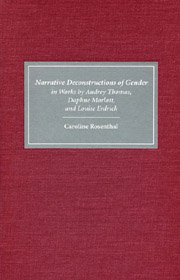Book contents
- Frontmatter
- Contents
- Dedication
- Preface and Acknowledgments
- Abbreviations
- Introduction
- 1 Framing Theories
- 2 “Alice Hoyle: 1,000 Interlocking Pieces”: Identity Deconstructions in Audrey Thomas's Intertidal Life
- 3 “You Can't Even Imagine?”: Monstrous Possibilities of Female Identity in Daphne Marlatt's Ana Historic
- 4 “Her Laugh an Ace”: Narrative Tricksterism in Louise Erdrich's Tetralogy
- Conclusion
- Works Consulted
- Index
2 - “Alice Hoyle: 1,000 Interlocking Pieces”: Identity Deconstructions in Audrey Thomas's Intertidal Life
Published online by Cambridge University Press: 05 February 2013
- Frontmatter
- Contents
- Dedication
- Preface and Acknowledgments
- Abbreviations
- Introduction
- 1 Framing Theories
- 2 “Alice Hoyle: 1,000 Interlocking Pieces”: Identity Deconstructions in Audrey Thomas's Intertidal Life
- 3 “You Can't Even Imagine?”: Monstrous Possibilities of Female Identity in Daphne Marlatt's Ana Historic
- 4 “Her Laugh an Ace”: Narrative Tricksterism in Louise Erdrich's Tetralogy
- Conclusion
- Works Consulted
- Index
Summary
Introduction: Beachcombers in the Intertidal Zone
I already knew the power of language to destroy, to omit, to obliterate. But poetry, the power of language to restore […].
Anne Michaels, Fugitive PiecesAs the title Intertidal Life suggests, Audrey Thomas's 1984 novel depicts the story of a woman who is caught in-between the erratic tides of convention and difference. In an attempt to construct a new identity for herself after a severe rupture in her life story, Thomas's protagonist, Alice Hoyle, oscillates between traditional, socially accepted positions for women and new identities she imagines for herself. The title not only points to the plot but also to the textual devices of Thomas's narrative that moves back and forth between fixture and fluidity, fact and fiction. The laws and features of the intertidal zone are the underlying structural device of the novel. Much in the same way that the protagonist wanders through the tidepools to observe different creatures, Thomas guides the reader through a textual landscape that vacillates between fixed forms such as etymologies and dictionary entries, and new, fluid forms created by Alice such as anagrams and puns.
There are two narrative strands in the novel that create a double vision on the same events. The inner story recalls the waves of pain, anger, and devastation that washed over Alice after her husband, Peter, left her and their three daughters after fourteen years of marriage.
- Type
- Chapter
- Information
- Narrative Deconstructions of Gender in Works by Audrey Thomas, Daphne Marlatt, and Louise Erdrich , pp. 29 - 65Publisher: Boydell & BrewerPrint publication year: 2003

